Acoustic Monitoring in Land-Based Oil & Gas
Operations in land-based Oil & Gas facilities—especially LNG processing plants and oil & gas terminals—are defined by complexity, risk, and the need for unwavering reliability. The machinery is heavy-duty. The processes are tightly interlocked. And any deviation can compromise safety, disrupt production, or invite environmental and regulatory consequences.
In such settings, oversight is not optional—it’s critical.
Moving from Observation to Precision Monitoring
As the industry evolves, there’s a clear trend: fewer people in the field, more control from centralised operations. Automation delivers efficiency and consistency, but it comes at a cost—the eyes, ears, and instincts of experienced operators are no longer present on site.
That’s where acoustic monitoring comes in.
Squarehead’s advanced detection systems bring the audible awareness back into industrial operations—only this time, automated, objective, and scalable. Using directional microphone arrays and refined beamforming algorithms, these systems pick up and interpret the acoustic signatures emitted by machinery and process equipment—monitoring in real time, with precision that doesn’t fade under noise or fatigue.
Key acoustic monitoring capabilities
Acoustic monitoring can play a vital role across critical operations in Oil & Gas facilities:
LNG Processing Equipment: Detects subtle faults before they escalate. Valve leaks, pump cavitation, and compressor anomalies are flagged early—avoiding hazardous situations and unplanned shutdowns.
Terminal Operations: Identifies emerging mechanical issues—seal leaks, bearing wear, and equipment degradation—before they lead to failure. This ensures terminal infrastructure remains dependable and within safety margins.
Gas Leak Detection: Captures the high-frequency sound of gas escaping, enabling rapid localization. This supports quicker response, limits exposure, and reduces both environmental and safety risks.
LAND-BASED OIL & GAS
Why it matters
With Squarehead’s acoustic technology, operators can keep a constant ear on critical assets—without being physically present. Faults that might have once gone unnoticed are now identified in real time, allowing teams to intervene early, before problems grow.
The result? A more robust safety culture, higher equipment uptime, and a smoother path to compliance in one of the world’s most demanding industrial environments.
INTERESTED TO SEE HOW WE CAN IMPROVE YOUR ACOUSTIC SITUATIONAL AWARENESS?
CONTACT OUR INDUSTRIAL TEAM FOR MORE INFORMATION.


